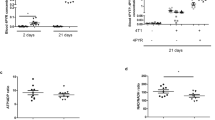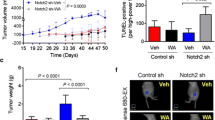Abstract
Breast cancer is the leading cause of cancer deaths among women worldwide. The theory of targeting both cancer cells directly and their blood supply has significant therapeutic potential. However, to date, there are few clinically successful single agents that meet these criteria. 2-Methoxyestradiol-3,17-O,O-bis-sulfamate (2-MeOE2bisMATE) and 2-ethylestradiol-3,17-O,O-bis-sulfamate (2-EtE2bisMATE) are potent inhibitors of proliferation in a range of cancer cells. The work presented here demonstrates the potent in vitro and in vivo effects of these compounds. They cause apoptosis via the intrinsic mitochondrial pathway in both MDA-MB-231 breast cancer cells and endothelial cells. Furthermore, they are potent anti-angiogenic inhibitors in vivo, as shown by their ability to reduce endothelial staining in MDA-MB-231 xenograft tumors. We have developed a novel, flow cytometry based, ex vivo method which shows in cells recovered from MDA-MB-231 tumors treated with 2-MeOE2bisMATE and 2-EtE2bisMATE an increase in intra-tumoral G2-M arrest and apoptosis. The degree of apoptosis inversely correlates to tumor volume. Further in vivo studies reveal that both 2-MeOE2bisMATE and 2-EtE2bisMATE are orally bioavailable and extremely efficacious when compared to clinically tested drugs. As these compounds are anti-proliferative against breast cancer and endothelial cells they have the potential to be potent, dual acting clinical drugs of the future.






Similar content being viewed by others
References
Parkin DM, Bray F, Ferlay J et al (2005) Global cancer statistics. CA Cancer J Clin 55:77–108
Smith IE, Dowsett M (2003) Aromatase inhibitors in breast cancer. N Engl J Med 48:2431–2442
Stanway SJ, Purohit A, Woo LWL et al (2006) Phase I study of STX 64 (667 Coumate) in breast cancer patients: the first study of a steroid sulfatase inhibitor. Clin Cancer Res 12:1585–1592
Nabholtz JM, Gligorov J (2005) The role of taxanes in the treatment of breast cancer. Expert Opin Pharmacother 6:1073–1094
Shak S (1999) Overview of the trastuzumab (Herceptin) anti-HER2 monoclonal antibody clinical program in HER2-overexpressing metastatic breast cancer. Semin Oncol 26:71–77
Hurwitz H, Fehrenbacher L, Novotny W et al (2004) Bevacizumab plus irinotecan, fluorouracil, and leucovorin for metastatic colorectal cancer. N Engl J Med 350:2335–2342
Vacca A, Iurlaro M, Ribatti D et al (1999) Antiangiogenesis is produced by nontoxic doses of vinblastine. Blood 94:4143–4155
Klement G, Baruchel S, Rak J et al (2000) Continuous low-dose therapy with vinblastine and VEGF receptor-2 antibody induces sustained tumor regression without overt toxicity. J Clin Invest 105:R15–R24
Hanahan D, Bergers G, Bergsland E (2000) Less is more, regularly: metronomic dosing of cytotoxic drugs can target tumor angiogenesis in mice. J Clin Invest 5:1045–1047
Bertolini F, Paul S, Mancuso P et al (2003) Maximum tolerable dose and low-dose metronomic chemotherapy have opposite effects on the mobilization and viability of circulating endothelial progenitor cells. Cancer Res 63:4342–4346
Zhu BT, Conney AH (1998) Is 2-methoxyestradiol an endogenous estrogen metabolite that inhibits mammary carcinogenesis? Cancer Res 58:2269–2277
Pribluda VS, Gubish ER Jr, Lavallee TM et al (2000) 2-Methoxyestradiol: an endogenous antiangiogenic and antiproliferative drug candidate. Cancer Metastasis Rev 19:173–179
Shang W, Konidari I, Schomberg DW (2001) 2-Methoxyestradiol, an endogenous estradiol metabolite, differentially inhibits granulosa and endothelial cell mitosis: a potential follicular antiangiogenic regulator. Biol Reprod 65:622–627
Dingli D, Timm M, Russell SJ et al (2002) Promising preclinical activity of 2-methoxyestradiol in multiple myeloma. Clin Cancer Res 8:3948–3954
Lakhani NJ, Sarkar MA, Venitz J et al (2003) 2-Methoxyestradiol, a promising anticancer agent. Pharmacotherapy 23:165–172
Mooberry SL (2003) New insights into 2-methoxyestradiol, a promising antiangiogenic and antitumor agent. Curr Opin Oncol 15:425–430
Dahut WL, Lakhani NJ, Gulley JL et al (2006) Phase I clinical trial of oral 2-methoxyestradiol, an antiangiogenic and apoptotic agent, in patients with solid tumors. Cancer Biol Ther 5:22–27
Newman SP, Ireson CR, Tutill HJ et al (2006) The role of 17β-hydroxysteroid dehydrogenases in modulating the activity of 2-methoxyestradiol in breast cancer cells. Cancer Res 66:324–330
Purohit A, Hejaz HA, Walden L et al (2000) The effect of 2-methoxyoestrone-3-O-sulphamate on the growth of breast cancer cells and induced mammary tumours. Int J Cancer 85:584–589
MacCarthy-Morrogh L, Townsend PA, Purohit A et al (2000) Differential effects of estrone and estrone-3-O-sulfamate derivatives on mitotic. Arrest, apoptosis, and microtubule assembly in human breast cancer cells. Cancer Res 60:5441–5450
Raobaikady B, Reed MJ, Leese MP et al (2005) Inhibition of MDA-MB-231 cell cycle progression and cell proliferation by C-2-substituted oestradiol mono- and bis-3-O-sulphamates. Int J Cancer 117:150–159
Newman SP, Leese MP, Purohit A et al (2004) Inhibition of in vitro angiogenesis by 2-methoxy- and 2-ethyl-estrogen sulfamates. Int J Cancer 109:533–540
Chander SK, Foster PA, Leese MP et al (2007) In vivo inhibition of angiogenesis by sulphamoylated derivatives of 2-methoxyoestradiol. Br J Cancer 96:1368–1376
Ireson CR, Chander SK, Purohit A et al (2004) Pharmacokinetics and efficacy of 2-methoxyoestradiol and 2-methoxyoestradiol-bis-sulphamate in vivo in rodents. Br J Cancer 90:932–937
Leese MP, Leblond B, Smith A et al (2006) 2-substituted estradiol bis-sulfamates, multitargeted antitumor agents: synthesis, in vitro SAR, protein crystallography, and in vivo activity. J Med Chem 28:7683–7696
Reers M, Smith TW, Chen LB (1991) J-aggregate formation of a carbocyanine as a quantitative fluorescent indicator of membrane potential. Biochemistry 30:4480–4486
Reers M, Smiley ST, Mottola-Hartshorn C et al (1995) Mitochondrial membrane potential monitored by JC-1 dye. Methods Enzymol 260:406–417
Di Lisa F, Blank PS, Colonna R et al (1995) Mitochondrial membrane potential in single living adult rat cardiac myocytes exposed to anoxia or metabolic inhibition. J Physiol (Lond) 486:1–13
Ellison G, Klinowska T, Westwood RFR et al (2002) Further evidence to support the melanocytic origin of MDA-MB-435. Mol Pathol 55:294–299
Sellappan S, Grijalva R, Zhou X et al (2004) Lineage infidelity of MDA-MB-435 cells: expression of melanocyte proteins in a breast cancer cell line. Cancer Res 64:3469–3485
Rae JM, Creighton CJ, Meck JM et al (2007) MDA-MB-435 cells are derived from M14 Melanoma cells-a loss for breast cancer, but a boon for melanoma research. Breast Cancer Res Treat 104:13–19
Day JM, Newman SP, Comninos A et al (2003) The effects of 2-substituted oestrogen sulphamates on the growth of prostate and ovarian cancer cells. J Steroid Biochem Mol Biol 84:317–325
Green DR, Kroemer G (2004) The pathophysiology of mitochondrial cell death. Science 30:626–629
Acknowledgment
Funding: This research was supported by Sterix Ltd., a member of the Ipsen Group.
Author information
Authors and Affiliations
Corresponding author
Rights and permissions
About this article
Cite this article
Foster, P.A., Ho, Y.T., Newman, S.P. et al. 2-MeOE2bisMATE and 2-EtE2bisMATE induce cell cycle arrest and apoptosis in breast cancer xenografts as shown by a novel ex vivo technique. Breast Cancer Res Treat 111, 251–260 (2008). https://doi.org/10.1007/s10549-007-9791-5
Received:
Accepted:
Published:
Issue Date:
DOI: https://doi.org/10.1007/s10549-007-9791-5




